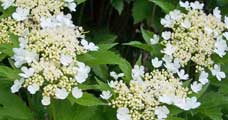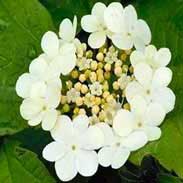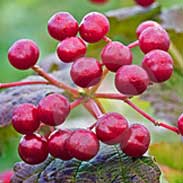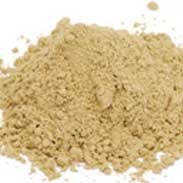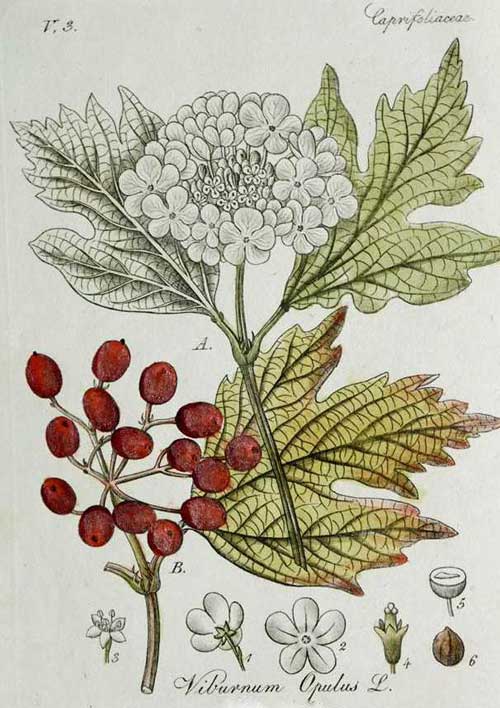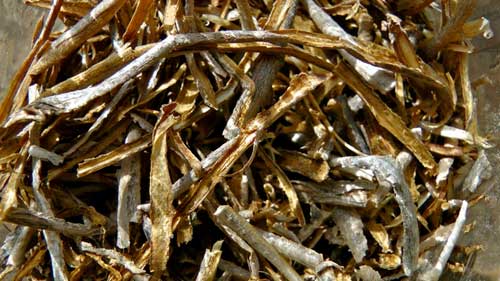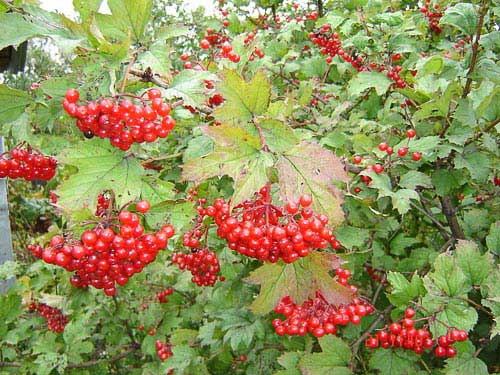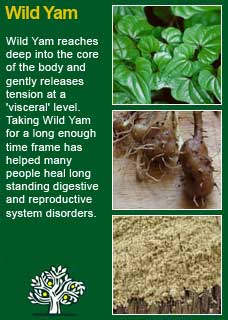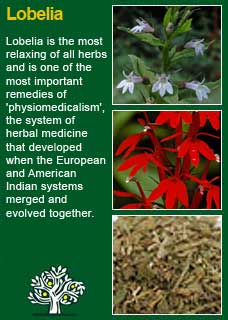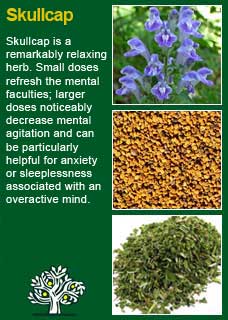
|
|
||||
| Our Pages ABOUT CONSTITUTIONAL MEDICINE
|
The well dried bark obtained from the stems of Cramp bark, a long-lived tree that grows up to 4 metres, is native to Europe and Asia and has wide, three lobed leaves that it sheds every year. Taking care to not overharvest, so that the tree survives, the bark from the branches is collected in Spring and in Summer when the plant is in flower and the medicinal properties are at their strongest.
Cramp bark has had so much popular use as a medicine over the centuries that its common name reflects exactly what it has been used for. As David Hoffmann says, 'Cramp bark has a richly deserved reputation for relaxing muscular tension and spasm, it has two primary areas of use: cramps of the voluntary muscles and uterine muscle problems' Cramp bark is perhaps most thought of as a women’s herb for helping with painful menstruation, but it is worth noting that there are lots of other traditional uses that show it has a general effect on spasm and tension elsewhere in the body. For example, Cramp bark has been historically used for migraine, asthma, biliary colic (from gall stones), renal colic (from kidney stones), and numerous different kinds of indigestion or bowel disturbances where cramp is the key feature. Native American medicine used Cramp bark for cramps and pains throughout the body. Andrew Chevallier says 'in some cases of arthritis, where joint weakness and pain have caused the muscles to contract until they are almost rigid, cramp bark can bring remarkable relief, as the muscles relax, blood flow to the area improves, waste products such as lactic acid are removed, and normal function can return' TJ Lyle writes 'Cramp bark is an admirable relaxing and stimulating, antispasmodic nervine. It quickly relieves the crampings of the limbs due to pregnancy, and also when not due to this condition. It quiets pain and uneasiness due to the pregnant period and prevents miscarriage' F Ellingwood writes 'the specific influence of Cramp bark is exercised in relieving irregular spasmodic pains of the womb and ovaries. It is antispasmodic in its action upon the entire pelvic viscera. One of its specific indications is pain from the pelvic organs which begin in the back, extending through to the loins and down the thighs. This is corrected with twenty drops every hour or two' King's Dispensatory writes 'Cramp bark is very effective in relaxing cramps and spasms of all kinds, as asthma, hysteria, cramps of the limbs or other parts in females, especially during pregnancy. It is highly beneficial to those who are subject to convulsions during pregnancy, or at the time of parturition, preventing the attacks entirely, if used daily for the last 2 months of gestation. Like Viburnum prunifolium, it is a remedy for the prevention of abortion, and to prepare the way for the process of parturition. It has been used in spasmodic contraction of the bladder, and in spasmodic stricture it allays uterine irritation while in the neuralgic and spasmodic forms of dysmenorrhoea and it is a favourite remedy with many physicians' The British Herbal Pharmacopoeia (BHP) describes the actions of Cramp bark as 'spasmolytic, sedative, astringent' and says it is indicated for 'spasmodic muscular cramp, uterine dysfunction, menopausal metrorrhagia, threatened miscarriage, partus praeparator, infantile enuresis' and specifically indicated 'for cramp, ovarian & uterine pains' The BHP recommends doses of 2-4 grams or by decoction and the extract at a dose of 2-4 mls. Thomas Bartram writes that the actions of Cramp bark include 'antispasmodic, astringent, nerve & muscle relaxant, sedative'. He suggests uses for it including 'muscular spasm, spasmodic pain in the abdomen, womb, ovaries, back, stomach, intestines, bladder. Painful menstruation. flooding menses of the menopause, polymyalgia rheumatica, nervous irritability, heart cramp (angina) intermittent claudication, arteritis, palpitation, earaches, acute bronchitis, asthma, muscular rheumatism, convulsions or bedwetting in children'.
~ Water extracts of Cramp bark were shown to have a digitalis-like cardiotonic effect in heart muscle tissue but Cramp bark does not contain cardiac glycosides - this study means that something in the herb causes the heart to beat more strongly and pump more blood (Vlad L, Munta A, Crisan IG: Planta Med 1977, 31:228-231) ~ Another study showed that injection of Cramp bark caused a lowering of heart rate and a dropping of blood pressure. The authors suggested that Cramp bark had a direct action on the relaxing the muscles and also thought the herb might be potentiating the action of acetylcholinesterase (Nicholson, J. A., Darby, T. D., and Jarboe, C. H. Viopudial, a hypotensive and smooth muscle antispasmodic from Viburnum opulus. Proc.Soc.Exp Biol.Med. 1972;140(2):457-461) ~ Laboratory studies showed that Cramp bark has relaxing effects on isolated uterine tissue. Extracts of Cramp bark were found to have inhibitory effects on the enzymes elastase, trypsin, and angiotensin in test tube studies (Jonadet M et al: Pharma Acta Helv 1989, 64(3):94-96) ~ iIn another study, Cramp bark extract was shown to increase the activity of superoxide dismutase, catalase, and gluthatione peroxidase (Zayachkivska, O. S., Gzhegotsky, M. R., Terletska, O. I., Lutsyk, D. A., Yaschenko, A. M., and Dzhura, O. R. Influence of Viburnum Opulus proanthocyanidins on stress-induced gastrointestinal mucosal damage. J Physiol Pharmacol 2006;57 Suppl 5:155-167) ~ In a laboratory study, some polysaccharides from Viburnum opulus berries enhanced phagocytosis, in particular, the phagocytic index and the secretion of lysosomal enzymes with peritoneal macrophages (Ovodova, R. G., Golovchenko, V. V., Popov, S. V., Shashkov, A. S., and Ovodov, IuS. [The isolation, preliminary study of structure and physiological activity of water-soluble polysaccharides from squeezed berries of Snowball tree Viburnum opulus]. Bioorg.Khim. 2000;26(1):61-67) ~ The authors, titles and the 'where-and-when' published of a handful of further studies and articles on Cramp bark are listed in a PDF found here
That said, it should not be taken in a larger dose than needed to get an effect as this will reduce the effectiveness of the herb, this paradoxical matter is discussed in more depth below. Cramp bark is an extremely safe herb that can and should be taken in pregnancy if there is concern for the uterus being overly tense and there being any threat of miscarriage; likewise, it may safely be used during breastfeeding and by the young and old.
For some years now, against this proven and safe way of herbalism, there has been a rising tide of excessive caution and scare-mongering in many parts of the world. The same authorities that, not so long ago, decried herbal medicines as ineffectual, have now taken up a different adversarial position; that they are dangerous substances that should only be prescribed by Doctors, who of course have zero training in them. Unfortunately, the same unnecessary fear and worry has crept into many natural health websites and popular publications on herbs. Herbs that we have safely used for thousands of years, that have no reports of adverse reactions in the medical literature despite widespread use by millions of people, are suddenly described as contraindicated because of something that should have been seen as completely unimportant, or at the utmost a merely theoretical concern, such as a laboratory study on one of the herb's constituents to use an all too common example. I wonder sometimes if the writers of such articles feel that the herb will be more deserving of respect if it is thought to be a little bit dangerous, in other words more like a drug than something that has simply come out of the earth and been used by ordinary people for generations beyond count. There is just so much misinformation about herbal medicine on the internet now. Ludicrous claims and cautions abound in equal measure; it seems like one group are trying to make money out of the public whilst the other are busily trying to scare them off. I have to believe that the kind of reader who takes the time to read pages on herbs that are as extensive as this one is much less likely to be swayed by marketers or misinformers. I hope that you will keep your wits about you if you get conflicting opinions from people who have never really got to know these herbs, who have never worked with them, or learned how to use them safely and effectively. I want to remind you that the reason that herbs can never be patented and owned by any individual or corporation is because they are, and always will be, the People's medicine. They belong to all of us and it is my great hope in sharing this work that you will learn how to use them wisely for yourself, and the people you care for. Be safe, but do not be afraid.
I find Cramp bark to be a simply fantastic herbal ally in clinical practice and have used a great deal of it for diverse people with many different problems; the common theme being that there is always too much tension in the physical body. Cramp bark has an uncanny ability to relax and soften those places that get too hard, too tense, and I have seen it help shift remarkably stubborn health problems over and over again. Cramp bark is helpful for too much physical tension anywhere, but it works particularly well on those muscles in our bodies that we don’t have much control over i.e. our digestive and urinary tract muscles, our lungs and for women, the womb. Cramp bark can be excellent for helping with painful periods and, equally, be as valuable for such problems as constricted breathing, functional bowel disorders, heart palpitations and chronic muscle pain from excess tension. Anyone who is studying herbal medicine or who simply wants to learn more about these great plant allies will do well to take a small dose of Cramp bark tincture (or some sips of its decoction although it should be noted that this will be a challenging taste for many and the tincture may be much easier to work with) and then, with a quiet and attentive mind, observe closely what they then feel happening in their body. I am sure that anyone who performs this old practice which we use to better understand the herb's 'action' will notice a palpable before and after difference when they do this. The words we use to describe such an action can only be a reflection of the reality of the feeling but when I have done this exercise with my colleagues or students the kinds of words that come up are 'softening, deepening, profoundly relaxing, warming, healing', incidentally our usual practice is to not let them know what they are testing until afterwards, so they just listen to their body rather than any expectations of the mind. Further to this, if you would like to learn more about the ancient art of pulse testing, a simple but powerful way to ask the intuitive intelligence of the body for its responses to a herb by feeling the pulse whilst giving a tiny dose by mouth, read here As I talk about more in a moment, getting the dose right is critical to success with Cramp bark and perhaps if you who are reading this simply need the help of this herb right now then the above exercise will also be an ideal way for you to learn immediately and directly just how much of it you might need to take. Note that once you get that palpable action then taking more of it will not necessarily work better and in fact may do you less good, one of the mysteries of herbs and healing is that sometimes less is more! In most cases the dose that a person can palpably feel only requires a modest amount; somewhere between as little as 5 drops to 20 drops, but people are variable in this regard, it is more than ok to experiment, it is probably necessary! If a problem that needs Cramp bark's help is acute and immediate than I suggest using it as frequently as required. This could mean taking it once every 15 to 20 minutes if things were quite bad and you needed to get its help right away. Again, this point needs to be reinforced, it is not that 'more is better' with this herb, the amount that you can feel working, even if it is only subtle at first, is the amount that you will increasingly get a therapeutic benefit from if you keep using it as often as you need. There is probably a little bit of a 'leap of faith' required here for a person who is not used to using herbs to help with pain and who's frame of reference has only been from analgesic drugs. Cramp bark will not stop the symptoms of pain by chemically altering your body's pain signalling. What it can do is help to treat the cause of the pain by helping to release tension in the area where the pain is coming from in the form of cramping, over-tightening muscles. This is why the 'small and often' approach can work the best. Each time you send a 'wave' of the Cramp bark's action through the system, the grip of tension is loosened a little bit more. You are resetting a level and must understand that you are working with the body, not overcoming it by brute chemical force. Be patient with this process as it may take an hour or two to get to where you need to go. Also, do not be too quickly discouraged if you start to relax and feel better but then all of a sudden get another spasm, this is normal as things unwind, it is ok if you take 3 steps forwards and then one back, you will still get there if you keep going! In the meanwhile, whatever you can do to better relax yourself to help the process along will only improve things further and faster. You know what relaxes you the best, reading, talking, listening to music, doing some kind of art of craft. Don't wait until you feel relaxed before doing what relaxes you, have a little faith in your own ability to reset your tension levels too! For a person who has a chronic problem that involves the kind of tension that Cramp bark can help heal then I recommend a daily dose of at least 1 or 2 mls to gradually ease the body into a more relaxed state of functioning. It is certainly ok to use higher doses if needed, Cramp bark shows how a great deal of the art of successful herbal medicine lies in getting the right dose - truly an art because one size most definitely does not fit all! I've almost only ever used Cramp bark as a tincture, so it is hard for me to make dosage recommendations with the tea though again I note that esteemed colleagues have a wide range of what they consider an effective dose range in this form as well. Cramp bark combines perfectly with Wild Yam for pain in the pelvic organs, with Lobelia for breathing difficulties and with Skullcap for excess nervous tension overall.
Much of the information here about the traditional uses of Cramp bark is consistent with the model of thinking whereby one may treat problem A with plant B. There is value in this approach, especially in how it helps us pass on useful knowledge to one another, but it falls short in one vital area; and that is that people are not all cut from the same cloth! Something that works brilliantly for one person may do less for another -- why is this? Part of the reason is that people vary in their constitutions as to whether they are either hotter or cooler and, at the same time, either dryer or damper. This useful and rather fascinating subject is introduced further here Another big part of using the right herb when it is most needed comes from understanding the need to treat what is going wrong for the person that had led up to their getting a health condition. In this light, Cramp bark can particularly offer its benefits when a relaxing action is needed in the 'cycle of healing', more about this here
Please understand that I cannot advise you, including on products or dosage, without seeing you in person in my clinic but for ideas
on how you might find a good herbalist in your area read here |
|
|
© 2011 R.J.Whelan Ltd
